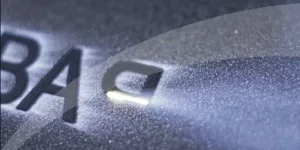
Creating clear and legible marks in manufacturing and production lines is important. The two most common methods include dot peen marking and laser marking. Manufacturers have used dot peen marking for decades, while laser marking uses advanced technology to mark with precision.
If you’re wondering which industrial marking machine to implement into your processes, this guide defines each method and provides the six biggest differences between the two to help you decide.
Laser marking is the process of changing a part’s surface with laser light. The targeted surface will gradually change through localized heating of the part, creating high-contrast markings. Two common types of laser marking systems include:
In contrast, dot peen marking systems, also known as pin engraving machines or pin stamping, use small rigid metal pins to create indents on a part. These pins leave small indentations to mark a part permanently. The two common dot marking systems are:
Both dot peen marking machines and laser marking systems can develop permanent markings on your products. However, there are distinct differences to consider when choosing a system that works effectively for you. Consider these six aspects where laser marking and dot peen marking differ.
If you work with aeronautics or automotive industries, dot peen systems are a common marking system seen in the industry. Pin engraving machines typically work well when marking rigid materials like hard plastic or metal. Even so, these materials often gain shallower marks and a rougher surface finish.
Laser marking machines may be a better alternative due to their ability to mark various types of materials like metal, plastic and organic materials. It can also mark delicate materials such as glass, paper and ceramics. Many businesses prefer to use this marking solution across industries.
With laser marking systems, you can apply various colorizations, text sizes and designs. It allows you to make precise markings and unique designs as small as 15 microns. Unlike laser marking solutions, dot peen engraving machines have a limited font size, type and dot density to stay legible.
Some marking options available with a dot marking system include data matrix codes, numbers and letters. Laser marking machines can help you perform more complex tasks like barcode marking and alphanumeric serial numbers. Another benefit of laser marking systems is that they can maintain readability even after surface treatments like powder coating, shot blasting, e-coating and heat treating.
Laser marking systems are particularly helpful for easy integration and implementation. You can use laser marking machines manually with a marking station or autonomously in a line.
You can also benefit from lower maintenance costs and less maintenance because the marking process is non-contact, creating less mechanical wear between the laser and part. And if it does require maintenance, replacement parts are easy to obtain.
In comparison, you can only use dot peen marking systems autonomously, and they require more complex considerations due to frequent stress from vibrations and shocks. These shocks and vibrations can cause considerable noise that may affect operators working near the system. This differs from laser marking processes, which are generally quieter because they are non-impact.
The frequent stress of dot peen engraving machines often leads to regular maintenance. In other cases, the marking quality may diminish faster than laser marking. With faster wear, you’ll need to find replacement parts more often, increasing your maintenance costs.
Another aspect in which dot peen marking systems and laser marking systems differ is their accuracy. While laser marking solutions can create precise and easy-to-read marks, pin engraving machines can leave less clear and legible markings. This is because, at some angles and in certain lighting, the indents of the markings can be more challenging to read at first glance.
Laser marking offers increased flexibility in what you can mark and the different shapes and colors you can implement accurately.
When working in production or manufacturing lines, speed is essential to keep up with cycle times. Laser marking systems have unmatched speed and can increase their power to process materials faster depending on how many watts a laser machine has. For example, a 100W laser may work twice as fast as a 50W laser.
These laser systems can also cover a larger area without physically moving, allowing them to mark even complex designs within seconds. In contrast, dot peen systems may take several seconds longer for the same design, making them less ideal for production lines. However, dot marking systems have better efficiency than laser systems when implementing deep engravings.
The biggest advantage of getting a dot peen marking machine is that it is cheaper than a laser marking system in the short run. While a pin engraving machine has a lower initial cost than a laser system, it will require higher long-term costs in terms of maintenance and repairs. The writing tip can deteriorate when marking harder materials, causing you to pay for replacement parts continually.
While laser marking systems have a higher initial price, you may benefit from lower long-term costs. This is because it has low maintenance requirements and less recurrent costs on repairs and energy. Additionally, laser marking machines will stay relevant for years because their marking capabilities grow with technology, while dot peen systems can quickly become outdated.
Dot peen marking machines have been the go-to for decades. While they can be a useful addition to your business with permanent markings and low purchase prices, laser marking systems have the capabilities needed to maintain high performance and surpass your competitors. If you’re ready to upgrade to a laser part marking system, consider Laser Marking Technologies.
Laser Marking Technologies is an industry-leading laser marking and engraving technology provider ready to help you meet your engraving needs. We have over a century of combined experience, and our experts have developed hundreds of laser marking system solutions for businesses. We encourage you to browse our selection of laser marking systems and contact our team today for a state-of-the-art marking solution.